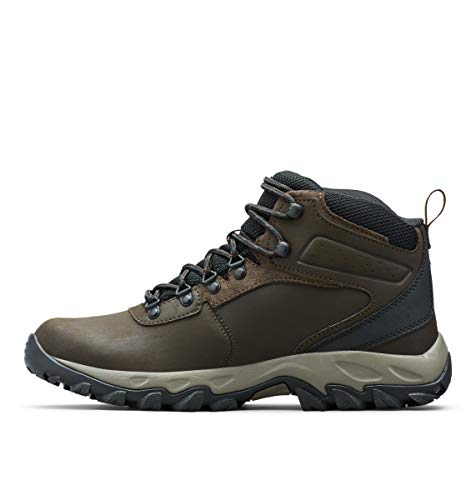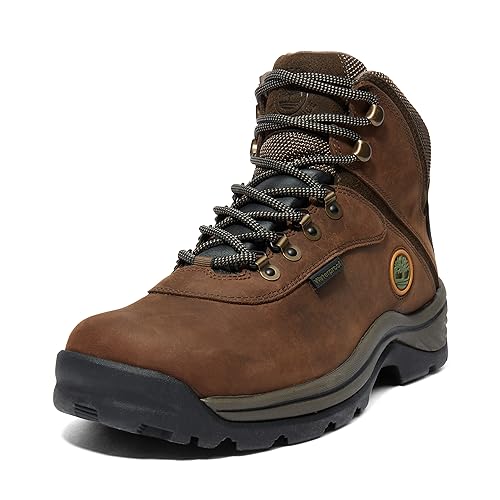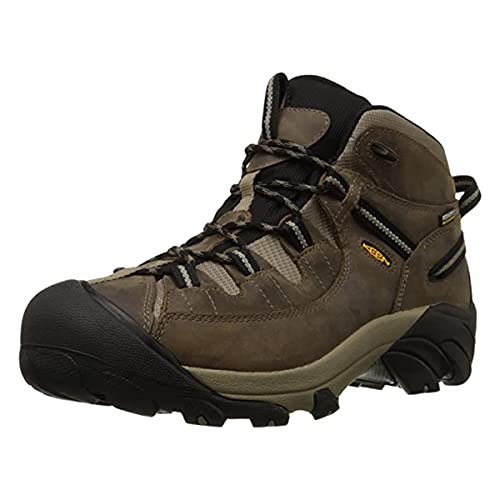TOP PICKS
Merrell Men's Moab 3 Mid Hiking Boot, Black Night, 11
- Pigskin leather and mesh upper 100% recycled laces and webbing Bellows tongue keeps out debris Protective toe cap 100% recycled mesh lining Kinetic Fit ADVANCED removable contoured insole with reinforced heel cushioning for medium support Molded nylon arch shankLightweight EVA foam midsole for stability and comfort Vibram TC5+ rubber sole
- Merrell is focused on merging performance, styling, and comfort to empower all people to confidently explore the outdoors
- Merrell Air Cushion in the heel absorbs shock and adds stability
−25%

Columbia mens Newton Ridge Plus Ii Waterproof Boot Hiking Shoe, Cordovan/Squash, 10.5 US
- ADVANCED TECHNOLOGY: Columbia Men's Newton Ridge Plus II Waterproof Hiking Boot features our lightweight, durable midsole for long lasting comfort, superior cushioning, and high energy return as well as an advanced traction rubber sole for slip-free movement on rough ground.
- HANDY FEATURES: Treacherous days out on the trail are comfortable and worry-free with this boot's waterproof full-grain leather and mesh bootie construction and its durable mesh tongue for breathability.
- ADJUSTABLE FEATURES: The Newton Ridge Plus II Waterproof Hiking Boot features a lace-up closure for an adjustable, secure fit.
- VERSATILE STYLE: This men's waterproof hiking boot delivers style and durability with its contrasting color combinations and soft mesh exterior.
- OMNI-GRIP: This multi-terrain traction system matches specially formulated compounds and treads to specific environments. A dual-zone winter tread pattern ensures solid footing on surfaces such as ice and snow.
Merrell Men's Moab 3 Mid Waterproof Hiking Boot, Earth, 11
- Waterproof membrane seals out water and lets moisture escape Pigskin leather and mesh upper 100% recycled laces and webbing Bellows tongue keeps out debris Protective toe cap 100% recycled mesh lining Kinetic Fit ADVANCED removable contoured insole with reinforced heel cushioning for medium support Molded nylon arch shankLightweight EVA foam midsole for stability and comfort Vibram TC5+ rubber sole
- Merrell is focused on merging performance, styling, and comfort to empower all people to confidently explore the outdoors
- Merrell Air Cushion in the heel absorbs shock and adds stability

Timberland Men's White Ledge Mid Waterproof Hiking Boot, Medium Brown, 7 Wide
- Our White Ledge Men's Hiking Boots have premium full-grain waterproof leather uppers, seam-sealed waterproof construction, and rustproof speed lace hardware with hooks at top for secure lacing.
- LOOK NO FURTHER for trail-ready performance and style. Our selection of men’s hiking boots, waterproof hiking boots, casual boots, and casual shoes is designed to fit in with your outdoor-ready ensembles.
- TIMBERLAND HAS YOU COVERED whether you're looking for men's boots, women's boots, or kids boots. For the best in hiking boots, rain boots, work boots, casual shoes & boots & more, choose Timberland.
- WHAT YOU NEED IN THE OUTDOORS: Timberland has the gear you need for all your outdoor adventures, including jackets and coats for outdoor activities, backpacks and luggage & outdoor accessories.
- Covered by the Timberland Limited Warranty. For complete terms, limitations, and instructions on how to make a warranty claim, please visit the Timberland website.
−25%
Timberland Men's Anti-Fatigue Hiking Waterproof Leather Mt. Maddsen Boot, Brown, 14
- Premium full-grain waterproof leather uppers
- TimberDry eco-conscious waterproof membrane keeps feet dry in any weather
- Fully gusseted tongue keeps out debris
- Anti-fatigue comfort technology provides all-day comfort
- Covered by the Timberland Limited Warranty. For complete terms, limitations, and instructions on how to make a warranty claim, please visit the Timberland website

Timberland mens Chocorua Trail Mid Waterproof hiking boots, Brown/Green, 10.5 Wide US
- These waterproof men's hiking boots mean business on the trails, lend a rugged aesthetic to your streetwear look, and use Timberdry membranes to keep your feet dry.
- LOOK NO FURTHER for trail-ready performance and style. Our selection of men’s hiking boots, waterproof hiking boots, casual boots, and casual shoes is designed to fit in with your outdoor-ready ensembles.
- TIMBERLAND HAS YOU COVERED whether you're looking for men's boots, women's boots, or kids boots. For the best in hiking boots, rain boots, work boots, casual shoes & boots & more, choose Timberland.
- WHAT YOU NEED IN THE OUTDOORS: Timberland has the gear you need for all your outdoor adventures, including jackets and coats for outdoor activities, backpacks and luggage & outdoor accessories.
- THE BEST IN OUTDOORS: Trust Timberland's line of high-quality men's, women's, and kids boots. hiking boots, outdoor gear, and activewear for all your activities from the trail to the sea to the streets.

Columbia Men's Buxton Peak Mid II Hiking Shoe, Nori/Black, 12
- ADVANCED TECHNOLOGY: The Buxton Peak Mid II waterproof boot features our Omni-Tech membrane bootie with seam-sealed construction. It combines with our Techlite lightweight midsole, for long-lasting comfort with superior cushioning and high energy return
- MOUNTAINEERING INSPIRED BOOT: The perfect combination of durability and performance designed into a modern boot. This versatile hiker will deliver all-day support and durable protection
- ALL TERRAIN TRACTION: Our signature Omni-Grip non-marking traction rubber outsole provides sure-footed grip across a wide variety of loose terrain, and yet safe and scuff-free indoors
- BUILT FOR COMFORT: You’ll find warm and happy feet in this reinforced suede leather boot that combines textile elements and webbing for exceptional fit and enhanced support
- REINFORCED CONSTRUCTION: Designed for wet excursions, we’ve reinforced the toe and heel barriers with an extended outsole and added a stitched toe overwrap to guard these key wear points, while rugged top metal lacing eyelets secure the fit
−33%

KEEN Men's Targhee 2 Mid Height Waterproof Hiking Boots
- WATERPROOF & PROTECTION: KEEN.DRY breathable membrane keeps feet dry and comfortable by allowing vapor out without letting water in; Bruise plate for protection on uneven surfaces; High abrasion rubber toe guard for added durability
- MATERIAL & CONSCIOUSLY CREATED: Durable premium leather and breathable performance mesh; Quick dry lining for active use; KEEN sources hides from Leather Working Group certified tanneries; Environmentally friendly DWR helps keep leather from drying out
- TRACTION: KEEN ALL-TERRAIN rubber provides high traction grip in muddy environments and on rocky surfaces; 4mm multi direction lugs provide optimal traction for sure footing; Non marking rubber outsoles leaves no imprints when walking indoors
- SUPPORT & COMFORT: External Support Shank and mid cut height adds balance and ankle support; Contoured heel for stability; Removable footbed with arch support cradles to the foot’s shape; Resilient cushioning doesn’t compress quickly after extended use
- FIT & CARE: KEEN Original Fit gives generous space for toes to spread out; Gently brush leather with a soft bristle brush or hand towel to remove loose dirt and debris; Tough stains may require a leather cleaner
−40%

KEEN Men's Targhee 3 Mid Height Waterproof Hiking Boots, Black Olive/Golden Brown, 10.5 Wide
- WATERPROOF & PROTECTION: KEEN.DRY breathable membrane keeps feet dry and comfortable by allowing vapor out without letting water in; Bruise plate for protection on uneven surfaces; High abrasion rubber toe guard for added durability
- MATERIAL & CONSCIOUSLY CREATED: Durable premium leather and breathable performance mesh; Quick dry lining for active use; KEEN sources hides from Leather Working Group certified tanneries; Environmentally friendly DWR helps keep leather from drying out
- TRACTION: KEEN ALL-TERRAIN rubber provides high traction grip in muddy environments and on rocky surfaces; 4mm multi direction lugs provide optimal traction for sure footing; Non marking rubber outsoles leaves no imprints when walking indoors
- SUPPORT & COMFORT: External Support Shank and mid cut height adds balance and ankle support; Heel cradle for stability; Removable footbed with arch support cradles to the foot’s shape; Resilient cushioning doesn’t compress quickly after extended use
- FIT & CARE: KEEN Original Fit gives generous space for toes to spread out; Gently brush leather with a soft bristle brush or hand towel to remove loose dirt and debris; Tough stains may require a leather cleaner
BUYING GUIDE
When it comes to hiking, the importance of a good pair of boots cannot be overstated. The right boots can make the difference between a fantastic day on the trail and a miserable one filled with blisters and sore feet. For men who love the great outdoors, investing in a quality pair of hiking boots is essential for safety, comfort, and performance. But with numerous brands, styles, and technical specifications to sift through, choosing the right pair can be daunting. This buying guide aims to simplify that process, detailing the key factors to consider when shopping for men’s hiking boots.
1. Intended Use:
The type of hiking you plan to do is crucial in deciding the right boots. Day hikes usually require lighter, more flexible boots, while backpacking and mountain hiking might require sturdier boots with better ankle support and durability.
2. Material:
Hiking boots are commonly made from full-grain leather, nubuck leather, or synthetic materials. Each material has its pros and cons concerning durability, breathability, and water resistance. Consider your needs and pick accordingly.
3. Fit:
A proper fit is essential. Poorly fitting boots can lead to discomfort and potential injuries. It’s best to try on boots in the afternoon when your feet are slightly swollen to get an accurate fit. Don’t forget to wear the type of socks you’ll be hiking in when trying them on.
4. Ankle Support:
Depending on the terrain and the weight of your backpack, you’ll need to decide between high-cut, mid-cut, or low-cut boots. High-cut boots offer the most ankle support but can be restrictive, while low-cut options are more flexible but offer less protection.
5. Sole and Traction:
Look for boots with a good quality rubber sole that offers grip and durability. Vibram soles are often considered the gold standard. The tread pattern also plays a role; deeper lugs generally provide better grip.
6. Waterproofing:
While not always necessary, waterproof boots can be a lifesaver in wet conditions. Look for boots with a waterproof yet breathable membrane like Gore-Tex for the best of both worlds.
7. Weight:
Lightweight boots are generally more comfortable and require less energy to move around but might offer less support and durability than heavier boots.
8. Break-in Time:
Some boots require a break-in period before they become comfortable. Full-grain leather boots often have the longest break-in time, while synthetic models usually require less time.
9. Ventilation:
Breathability is crucial, especially in hot conditions. Look for boots with breathable materials or ventilation features to help manage moisture and keep your feet dry.
10. Insoles and Cushioning:
Quality insoles can make a significant difference in your hiking experience. Some boots come with high-quality insoles, or you can purchase aftermarket insoles for better arch support and cushioning.
11. Lacing System:
A good lacing system allows you to adjust the fit easily and securely. Speed lacing systems are convenient but might not offer the same level of customization as traditional laces.
12. Price and Warranty:
Good hiking boots are an investment. Higher-priced boots often offer better durability and comfort. Check if the boots come with a warranty for added peace of mind.
Now that you’re equipped with this knowledge, you’re ready to embark on the journey to find the perfect pair of men’s hiking boots. Remember, the best boots for you are the ones that meet your specific needs in terms of comfort, support, and durability. Happy trails!












